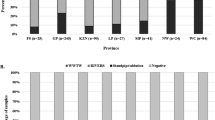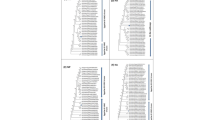Abstract
Porcine circovirus 2 (PCV2) has been widely prevailing in China since the first report in 2001, causing huge economic losses to the pig industry. In the present study, 674 samples were collected from 2006 to 2016 in Hunan province, and 62% were positive for PCV2. An increase was observed from 2006 to 2011 (72.1%-89.1%), and a decrease was observed from 2012 to 2016 (78.9%-36.8%). The prevalence of genotype PCV2a, PCV2b, and PCV2d was 0, 44.7% and 67%, respectively. During 2006-2007, PCV2b was the main genotype circulating in Hunan, while, in 2008, PCV2d became the predominant one. Coinfection with PCV2b and PCV2d was observed frequently, and the positive rates of coinfection ranged from 6.3% to 18.9% during 2006-2016. The complete genome was sequenced for 54 positive samples, and four were identified as PCV2b-1, 22 as PCV2b-2, four as PCV2d-1 and 24 as PCV2d-2, based on phylogenetic analysis of the complete genome and ORF2 region. Recombination analysis using the complete genome sequences of these isolates revealed a high recombination rate of 27.7% (17/54), and showed that recombination occurred mainly in the ORF1 region. This shows that the prevalence of PCV2 has clearly decreased in recent years and that PCV2d has become a predominant genotype since 2008. In addition, frequent recombination events were observed in the PCV2 isolates from Hunan, China.



Similar content being viewed by others
References
de Boisseson C, Beven V, Bigarre L, Thiery R, Rose N, Eveno E, Madec F, Jestin A (2004) Molecular characterization of Porcine circovirus type 2 isolates from post-weaning multisystemic wasting syndrome-affected and non-affected pigs. J Gen Virol 85(Pt 2):293–304
Timmusk S, Wallgren P, Brunborg IM, Wikstrom FH, Allan G, Meehan B, McMenamy M, McNeilly F, Fuxler L, Belak K, Podersoo D, Saar T, Berg M, Fossum C (2008) Phylogenetic analysis of porcine circovirus type 2 (PCV2) pre- and post-epizootic postweaning multisystemic wasting syndrome (PMWS). Virus Genes 36(3):509–520
Wen L, Guo X, Yang H (2005) Genotyping of porcine circovirus type 2 from a variety of clinical conditions in China. Vet Microbiol 110(1–2):141–146
Olvera A, Cortey M, Segales J (2007) Molecular evolution of porcine circovirus type 2 genomes: phylogeny and clonality. Virology 357(2):175–185
Dupont K, Nielsen EO, Baekbo P, Larsen LE (2008) Genomic analysis of PCV2 isolates from Danish archives and a current PMWS case–control study supports a shift in genotypes with time. Vet Microbiol 128(1):56–64
Hesse R, Kerrigan M, Rowland RR (2008) Evidence for recombination between PCV2a and PCV2b in the field. Virus Res 132(1–2):201–207
Huang Y, Shao M, Xu X, Zhang X, Du Q (2013) Evidence for different patterns of natural inter-genotype recombination between two PCV2 parental strains in the field. Virus Res 175(1):78–86
Ramos N, Mirazo S, Castro G, Arbiza J (2013) Molecular analysis of Porcine Circovirus Type 2 strains from Uruguay: evidence for natural occurring recombination. Infect Genet Evol 19:23–31
Allan G, Krakowka S, Ellis J, Charreyre C (2012) Discovery and evolving history of two genetically related but phenotypically different viruses, porcine circoviruses 1 and 2. Virus Res 164(1–2):4–9
Segalés J, Kekarainen T, Cortey M (2013) The natural history of porcine circovirus type 2: from an inoffensive virus to a devastating swine disease? Vet Microbiol 165(1–2):13–20
Grau-Roma L, Fraile L, Segal SJ (2011) Recent advances in the epidemiology, diagnosis and control of diseases caused by porcine circovirus type 2. Vet J 187(1):23–32
Huang L, Wang Y, Wei Y, Chen D, Liu D, Du W, Xia D, Wu H, Feng L, Liu C (2016) Capsid proteins from PCV2a genotype confer greater protection against a PCV2b strain than those from PCV2b genotype in pigs: evidence for PCV2b strains becoming more predominant than PCV2a strains from 2000 to 2010s. Appl Microbiol Bio 100(13):5933–5943
Franzo G, Cortey M, Olvera A, Novosel D, Castro AM, Biagini P, Segales J, Drigo M (2015) Revisiting the taxonomical classification of Porcine Circovirus type 2 (PCV2): still a real challenge. Virol J 12:131
Xiao C, Halbur PG, Opriessnig T (2015) Global molecular genetic analysis of porcine circovirus type 2 (PCV2) sequences confirms the presence of four main PCV2 genotypes and reveals a rapid increase of PCV2d. J Gen Virol 96(7):1830–1841
Guo LJ, Lu YH, Wei YW, Huang LP, Liu CM (2010) Porcine circovirus type 2 (PCV2): genetic variation and newly emerging genotypes in China. Virol J 7(1):273–284
Jiang C, Wang G, Tu Y, Liu Y, Wang S, Cai X, An T (2017) Genetic analysis of porcine circovirus type 2 in China. Arch Virol 162(9):2715–2726
Kwon T, Lee DU, Yoo SJ, Je SH, Shin JY, Lyoo YS (2017) Genotypic diversity of porcine circovirus type 2 (PCV2) and genotype shift to PCV2d in Korean pig population. Virus Res 228:24–29
Xiao CT, Harmon KM, Halbur PG, Opriessnig T (2016) PCV2d-2 is the predominant type of PCV2 DNA in pig samples collected in the U.S. during 2014-2016. Vet Microbiol 197:72–77
Xiao CT, Halbur PG, Opriessnig T (2012) Complete genome sequence of a novel porcine circovirus type 2b variant present in cases of vaccine failures in the United States. J Virol 86(22):12469
Seo HW, Park C, Kang I, Choi K, Jeong J, Park SJ, Chae C (2014) Genetic and antigenic characterization of a newly emerging porcine circovirus type 2b mutant first isolated in cases of vaccine failure in Korea. Arch Virol 159(11):3107
Wang F, Guo X, Ge X, Wang Z, Chen Y, Cha Z, Yang H (2009) Genetic variation analysis of Chinese strains of porcine circovirus type 2. Virus Res 145(1):151–156
Katoh K, Standley DM (2013) MAFFT multiple sequence alignment software version 7: improvements in performance and usability. Mol Biol Evol 30(4):772–780
Martin DP, Murrell B, Golden M, Khoosal A, Muhire B (2015) RDP4: detection and analysis of recombination patterns in virus genomes. Virus Evol 1:1
Tamura K, Stecher G, Peterson D, Filipski A, Kumar S (2013) MEGA6: molecular evolutionary genetics analysis version 6.0. Mol Biol Evol 30(12):2725–2729
Xiao CT, Halbur PG, Opriessnig T (2015) Global molecular genetic analysis of porcine circovirus type 2 (PCV2) sequences confirms the presence of four main PCV2 genotypes and reveals a rapid increase of PCV2d. J Gen Virol 96(Pt 7):1830–1841
Xia X, Xie Z (2001) DAMBE: software package for data analysis in molecular biology and evolution. J Hered 92(4):371–373
Darriba D, Taboada GL, Doallo R, Posada D (2012) jModelTest 2: more models, new heuristics and parallel computing. Nat Methods 9(8):772
Yang ZZ, Shuai JB, Dai XJ, Fang WH (2008) A survey on porcine circovirus type 2 infection and phylogenetic analysis of its ORF2 gene in Hangzhou, Zhejiang Province, China. J Zhejiang Univ Sci B 9(2):148–153
Yan Z (2009) Epidemiological study of Poreine Circovirus type2 infection and trituration, application of inactived vaccine in Anyang (in chinese)[Dissertation]. Henan Agricultral University, Zhengzhou
Meng S, Ya-hui LU, Qian DU, Le S, Yong H, De-wen T (2013) Molecular epidemiological investigation on porcine circovirus type 2 in Shaanxi Province during 2010-2012 (in chinese). J Northwest Agric For Univ (Nat Sci Ed) 41(10):19–26
Jing D, Chunrong Z, Sanjie C, Xintain W, Xiaobo H (2014) Molecular epidemiological investigation of porcine circovirus type 2 between 2010 and 2013 in some regions of Sichuan (in chinese). Chin J Vet Sci 12:1868–1876
Jun Z, Tongfeng Z, Pengjuan L, Jianbo H, Ziyi J (2016) Molecular epidemiology of porcine circovirus type 2 in diarrhea piglets in Sichuan region (in chinese). Chin J Prev Vet Med 38(7):546–549
Shaojian X (2013) Studies on Molecular Epidimiology of PCV2 and the interaction of JAK-STAT signal pathways with infection of PCV2 [Dissertation]. Shandong agricultural university
Yuan WU, Hong-Bing Z, Xin-Yan W, Wei-Hua B, Hong-Jie F (2013) Molecular epidemiological investigation of porcine circovirus type 2 (PCV2) in Zhejiang Province and surrounding areas. J Agric Biotechnol 4:456–463
Meng G, Chunhu S, Chenxu X, Xing L, Lin Y, Yakun L, Kuhua J, Sujuan C, Daxin P, Xiufan L (2014) Molecular epidemiological surveillance of porcine circovirus type 2 in part of Jiangsu province (in chinese). Chin J Anim Health Insp 2:62–66
Zhai SL, Chen SN, Xu ZH, Tang MH, Wang FG, Li XJ, Sun BB, Deng SF, Hu J, Lv DH, Wen XH, Yuan J, Luo ML, Wei WK (2014) Porcine circovirus type 2 in China: an update on and insights to its prevalence and control. Virol J 11(1):88–100
Luo W, Zhao D, Wang X, Jiang DL, Li RC, Yu XL (2013) Type differentiation of porcine circovirus from tissues of sick pigs and replication characteristics of different strains of PCV2. J Hum Agric Univ (Natural Sci) 6:626–630 (In Chinese)
Qian-qian Z, Bing-lin Z, Wei-huan F (2010) Analysis and comparison of genomic sequences of porcine circovirus type 2 isolates in Zhejiang Province between 2008 and 2009 (in chinese). Chin Vet Sci 6:565–571
Zhan Y, Wang N, Zhu Z, Wang Z, Wang A, Deng Z, Yang Y (2016) In silico analyses of antigenicity and surface structure variation of an emerging porcine circovirus genotype 2b mutant, prevalent in southern China from 2013 to 2015. J Gen Virol 97(4):922–933
Ge M, Yan A, Luo W, Hu YF, Li RC, Jiang DL, Yu XL (2013) Epitope screening of the PCV2 Cap protein by use of a random peptide-displayed library and polyclonal antibody. Virus Res 177(1):103
Lekcharoensuk P, Morozov I, Paul PS, Thangthumniyom N, Wajjawalku W, Meng XJ (2004) Epitope mapping of the major capsid protein of type 2 porcine circovirus (PCV2) by using chimeric PCV1 and PCV2. J Virol 78(15):8135–8145
Mahé D, Blanchard P, Truong C, Arnauld C, Le Cann P, Cariolet R, Madec F, Albina E, Jestin A (2000) Differential recognition of ORF2 protein from type 1 and type 2 porcine circoviruses and identification of immunorelevant epitopes. J Gen Virol 81(Pt 7):1815
Franzo G, Cortey M, Segales J, Hughes J, Drigo M (2016) Phylodynamic analysis of porcine circovirus type 2 reveals global waves of emerging genotypes and the circulation of recombinant forms. Mol Phylogenet Evol 100:269–280
Funding
This study was supported by the National Key Research and Development Program of China (2017YFD0500104).
Author information
Authors and Affiliations
Corresponding author
Ethics declarations
Conflict of interest
None.
Ethical approval
This article does not contain any studies with human participants or animals performed by any of the authors.
Additional information
Handling Editor: Roman Pogranichniy.
Electronic supplementary material
Below is the link to the electronic supplementary material.
Rights and permissions
About this article
Cite this article
Qu, T., Li, R., Yan, M. et al. High prevalence of PCV2d in Hunan province, China: a retrospective analysis of samples collected from 2006 to 2016. Arch Virol 163, 1897–1906 (2018). https://doi.org/10.1007/s00705-018-3823-9
Received:
Accepted:
Published:
Issue Date:
DOI: https://doi.org/10.1007/s00705-018-3823-9




